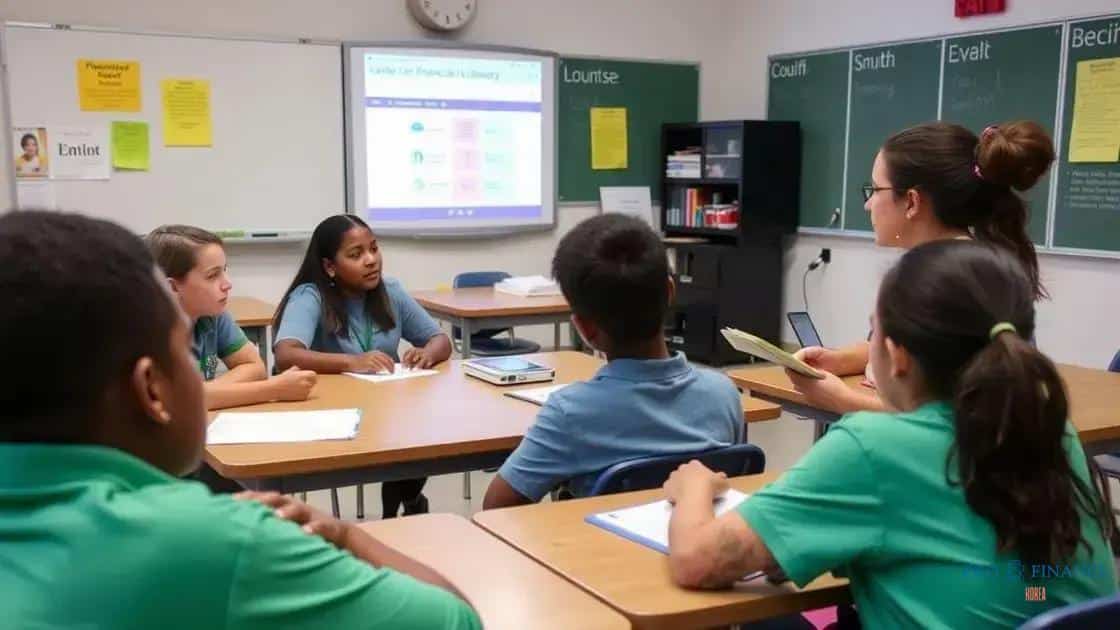The growing importance of financial literacy programs in schools

The growing importance of financial literacy programs in schools equips students with essential skills for managing money, fostering informed financial decisions and preparing them for successful futures.
The growing importance of financial literacy programs in schools is sparking conversations about how we prepare young minds for financial decisions. Have you ever wondered how these programs shape students’ futures?
Understanding financial literacy
Understanding financial literacy is essential for all students in today’s world. It helps them navigate the complex financial landscape they will encounter as adults. Having a strong grasp of financial concepts can empower students to make informed decisions throughout their lives.
Financial literacy encompasses various skills, including budgeting, saving, investing, and understanding credit. By learning these skills early, students can develop responsible financial habits that last a lifetime.
The key components of financial literacy
There are several crucial aspects to financial literacy that students should be aware of, including:
- Budgeting: Understanding how to create and stick to a budget is foundational for managing money effectively.
- Saving: Building an emergency fund and saving for future goals are vital for financial security.
- Investing: Learning about investments helps students grow their wealth over time.
- Credit: Knowing how credit works is necessary for making informed decisions about loans and interest rates.
When students grasp these components, they are better prepared to deal with opportunities and challenges they might face in their financial journey.
Effective financial literacy programs can significantly influence students’ understanding. These programs often provide students with practical tools and resources, enabling them to apply what they learn in real-life situations. It’s not just about theory; learning through simulations and active participation can solidify their knowledge.
Proven strategies, such as interactive workshops and real-world case studies, help students relate better to the material. Workshops can cover everything from understanding student loans to managing daily expenses. Such hands-on experiences can reinforce the lessons learned in the classroom.
Moreover, involving parents in financial literacy initiatives can create a family culture of financial awareness. When students discuss their lessons with their families, it allows for richer understanding and reinforces the importance of being financially savvy.
Ultimately, the goal of financial literacy education is to prepare students for their financial futures. As they learn to manage their money wisely, they will gain confidence and independence in their economic lives.
Benefits of financial literacy programs

Benefits of financial literacy programs are numerous and impactful for students. These programs equip young learners with essential skills for managing their finances effectively. By participating in financial literacy programs, students gain a deeper understanding of money management and the importance of making informed financial decisions.
One major benefit is that students learn to budget. Creating a budget allows them to track their income and expenses, helping them understand the value of saving. This skill fosters responsible financial behavior that can lead to a more secure future.
Enhancing decision-making skills
Another advantage of financial literacy programs is the enhancement of decision-making skills. Students learn how to weigh options carefully and consider the long-term consequences of their financial choices. This critical thinking ability extends beyond finance and positively affects various aspects of their lives.
- Understanding how to assess loan options and interest rates.
- Evaluating the pros and cons of purchasing versus renting.
- Identifying potential investment opportunities.
- Making choices about credit cards and managing debt.
By developing these skills, students become more confident in their financial literacy. This confidence often translates into better financial habits as they enter adulthood.
Additionally, financial literacy programs promote a culture of savings. When students understand the importance of saving early, they are more likely to prioritize it throughout their lives. They learn about different savings vehicles, such as savings accounts and investment options, which encourage them to put aside a portion of their income regularly.
Moreover, these programs positively impact students’ academic performance. Research shows that students with strong financial literacy skills tend to have better problem-solving capabilities and time management skills. These attributes contribute to success in school and beyond.
Furthermore, financial literacy education fosters an awareness of economic issues that affect individuals and communities. Students learn about topics like inflation, taxes, and economic instability. This knowledge enables them to understand their roles in the economy and the importance of financial participation.
In conclusion, the benefits of financial literacy programs extend far beyond simple money management. They help shape well-rounded individuals who are prepared for the financial realities of adulthood, creating a foundation for a lifetime of informed financial decisions.
How schools can implement these programs
How schools can implement these programs effectively is a vital question for educators and administrators. Integrating financial literacy into the school curriculum can equip students with the knowledge and skills they need for a successful financial future. Schools can start this process by assessing their current curriculum and identifying gaps where financial education can fit in.
A collaborative approach is essential for successful implementation. Schools can work with financial institutions and local businesses to provide resources and support for their programs. Partnerships can offer students real-world perspectives and insights into financial management.
Steps for successful implementation
There are specific steps schools can take to ensure a successful financial literacy program:
- Conduct a needs assessment to understand student knowledge and gaps in financial literacy.
- Design a curriculum that meets state standards but can also be tailored to local needs.
- Train teachers to deliver financial literacy lessons effectively, using engaging methods.
- Incorporate hands-on activities that encourage practical application of financial concepts.
Beyond the classroom, schools can host workshops and seminars for parents and community members. This helps to create a broader culture of financial literacy within the community. Involving the community reinforces the importance of financial education for all ages.
Another effective method is to use technology and online resources. Many interactive programs and apps are available, making learning about finance fun and engaging. Students can benefit from simulations that teach budgeting, investing, and even how to handle real-life financial scenarios.
Furthermore, schools should evaluate and adapt their programs regularly. Feedback from students and teachers will provide valuable insights into what is working and what needs improvement. Continuous evaluation ensures that the programs remain relevant and impactful over time.
By taking these steps, schools can create a solid foundation for financial literacy education. This proactive approach not only benefits students but also helps to develop responsible future citizens equipped with essential life skills.
Challenges in teaching financial literacy
Challenges in teaching financial literacy are significant hurdles that educators face. Despite the clear benefits of financial education, there are various obstacles to effectively teaching these crucial concepts. Understanding these challenges can help schools develop better strategies for financial literacy programs.
One major challenge is the lack of trained teachers. Many educators may not feel confident in their own financial knowledge, which can lead to ineffective teaching. If teachers don’t have a strong grasp of financial concepts themselves, it can be difficult to inspire students to learn.
Curriculum integration
Another obstacle is integrating financial literacy into an already packed curriculum. With so many subjects to cover, finding time for financial education can be tough. Schools often prioritize traditional subjects like math and science, which may leave little room for essential life skills like budgeting and saving.
- Finding time within the academic schedule for financial literacy lessons.
- Aligning financial education with state standards and assessments.
- Acquiring resources and materials to support classroom instruction.
- Addressing diverse student backgrounds and varying levels of financial experience.
Furthermore, engaging students can be a challenge. Many students may view financial literacy as boring or irrelevant. It’s essential to present the material in a way that is relatable and interactive. Using real-life examples, games, and technology can help make the subject more appealing.
Additionally, there is often a lack of community and parental involvement in financial education. Without support from families, students may not take the lessons seriously or have the opportunity to practice their skills outside the classroom.
Addressing these challenges requires creativity and commitment from educators. Professional development opportunities for teachers, innovative teaching methods, and community partnerships can help alleviate some of these issues. By working together, schools can overcome these challenges and provide quality financial literacy education.
Success stories from schools promoting financial literacy
Success stories from schools promoting financial literacy highlight the positive impact of financial education on students. Many schools across the country have implemented effective programs that empower students with essential money management skills. These success stories serve as inspiring examples for other schools looking to enhance their own financial literacy initiatives.
One great example is a high school that integrated financial literacy into its curriculum. Students participated in interactive lessons that included budgeting exercises and real-life financial scenarios. By the end of the course, many students reported feeling more confident about their financial decisions, which is a clear indication of the program’s success.
Innovative programs
Another successful case comes from a middle school that partnered with local banks to offer hands-on workshops. During these workshops, students learned about saving and the importance of setting financial goals. The partnership allowed students to open savings accounts with small initial deposits, making learning about money practical and accessible.
- Students increased their savings rates by over 50% within a year.
- The program received positive feedback from parents, who noted an increase in discussions about finances at home.
- Community members supported the initiative by volunteering to share their experiences with money management.
- Students created presentations to educate their peers about budgeting and saving.
Success stories also include schools that have introduced financial literacy competitions. These competitions encourage teamwork and creativity as students develop financial plans for hypothetical businesses. Not only do participants gain knowledge, but they also build skills in collaboration and critical thinking.
Furthermore, financial literacy programs have shown academic benefits as well. Schools that prioritize financial education often see improvements in overall student performance. Students become more engaged and motivated when they see the real-world applications of what they learn.
These examples demonstrate that with the right approach, financial literacy education can make a significant difference in students’ lives. By providing concrete skills and knowledge, schools are preparing students for a successful financial future.
FAQ – Frequently Asked Questions about Financial Literacy Programs in Schools
What are the main benefits of financial literacy programs for students?
Financial literacy programs equip students with essential skills like budgeting and saving, empowering them to make informed financial decisions.
How can schools effectively implement financial literacy programs?
Schools can implement these programs by assessing needs, collaborating with local businesses, and using engaging teaching methods.
What challenges do schools face when teaching financial literacy?
Challenges include a lack of trained teachers, difficulty in integrating into the curriculum, and engaging students in the subject matter.
Can financial literacy education improve academic performance?
Yes, students involved in financial literacy programs often show improved problem-solving skills and overall academic performance.






